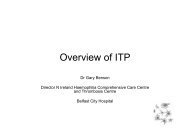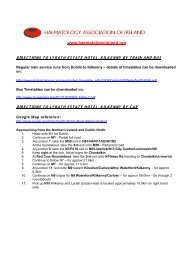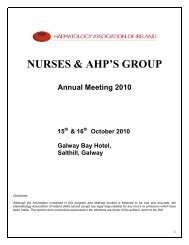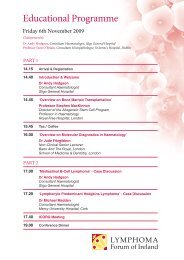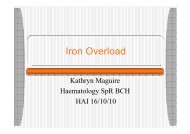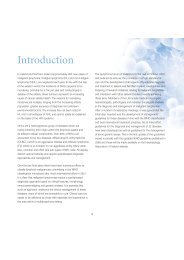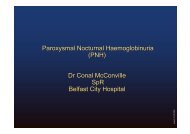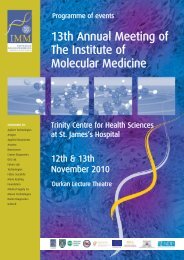Guidelines on Diagnosis and Treatment of Malignant Lymphomas
Guidelines on Diagnosis and Treatment of Malignant Lymphomas
Guidelines on Diagnosis and Treatment of Malignant Lymphomas
You also want an ePaper? Increase the reach of your titles
YUMPU automatically turns print PDFs into web optimized ePapers that Google loves.
Potential Pitfalls<br />
a. Failure to differentiate from reactive disease<br />
b. Failure to differentiate from mantle cell lymphoma<br />
c. Failure to grade <strong>and</strong> especially to distinguish grade 3b<br />
d. Failure to recognise as a comp<strong>on</strong>ent <strong>of</strong> DLBCL<br />
(diffuse large B-cell lymphoma) when FL has<br />
underg<strong>on</strong>e high- grade transformati<strong>on</strong><br />
<strong>Treatment</strong><br />
Stage I /II<br />
Radiati<strong>on</strong> therapy with curative intent is the treatment <strong>of</strong><br />
choice. Involved field radiotherapy using doses <strong>of</strong> 24-40Gy<br />
with potential dose adapti<strong>on</strong> according to disease resp<strong>on</strong>se<br />
should be used.<br />
Stage III/IV<br />
C<strong>on</strong>venti<strong>on</strong>al treatment is not curative <strong>and</strong> there is no evidence<br />
that early treatment <strong>of</strong> asymptomatic patients improves overall<br />
survival. <strong>Treatment</strong> should be delayed until disease becomes<br />
symptomatic, leads to critical organ impairment or undergoes<br />
high- grade transformati<strong>on</strong>. Sp<strong>on</strong>taneous regressi<strong>on</strong> may occur<br />
in 10- 20% <strong>of</strong> patients being observed.<br />
The least toxic, effective treatment should be used to avoid l<strong>on</strong>g<br />
term effects in patients who may have a prol<strong>on</strong>ged survival.<br />
Patients should be treated to a stable or asymptomatic disease<br />
status <strong>and</strong> then observed until disease progressi<strong>on</strong>. At this stage<br />
re-evaluati<strong>on</strong> is undertaken (tissue sampling <strong>and</strong> re-staging) <strong>and</strong><br />
further treatment planned. Disease which has not progressed for<br />
>2 years may be managed without escalated therapy. This<br />
approach results in a median survival <strong>of</strong> 8-13 years with patients<br />
receiving an average <strong>of</strong> 3 courses <strong>of</strong> treatment. Younger patients<br />
with good performance status at first or sec<strong>on</strong>d progressi<strong>on</strong><br />
should be c<strong>on</strong>sidered for potentially “curative approaches” using<br />
stem-cell transplantati<strong>on</strong>.<br />
Single agent chemotherapy<br />
Chlorambucil: can be used as pulse therapy (10mg/m2) for<br />
5 days every 28 days or c<strong>on</strong>tinuous low dose therapy, usually<br />
for 6 m<strong>on</strong>ths resulting in an ORR <strong>of</strong> about 80%. Chlorambucil is<br />
stem cell toxic <strong>and</strong> should be avoided if a stem cell harvest is<br />
being c<strong>on</strong>sidered.<br />
Fludarabine: Results in an ORR rate <strong>of</strong> 30-60% in relapsed<br />
disease <strong>and</strong> should be avoided if a stem cell harvest is<br />
being envisaged<br />
Rituximab: Active in >80% as a single agent in de novo patients<br />
<strong>and</strong> 65% <strong>of</strong> previously treated/refractory patients. No data<br />
supports its use as a first line single agent, but it may be useful in<br />
patients with compromised marrow or poor performance status.<br />
Combinati<strong>on</strong> chemotherapy<br />
R-CVP has an ORR <strong>of</strong> 81% <strong>and</strong> EFS <strong>of</strong> 32 m<strong>on</strong>ths after 8 cycles.<br />
R-CVP is not stem cell toxic <strong>and</strong> is useful first line therapy in<br />
patients 65 years.<br />
R-combinati<strong>on</strong> (anthracycline-c<strong>on</strong>taining): R-CHOP is indicated<br />
for rapid disease c<strong>on</strong>trol, in disease refractory to n<strong>on</strong>-anthracycline<br />
c<strong>on</strong>taining therapy, in patients with grade 3 disease or as sec<strong>on</strong>d<br />
line therapy. The use <strong>of</strong> RCHOP as primary chemotherapy is<br />
associated with a lower rate <strong>of</strong> high grade transformati<strong>on</strong>.<br />
Rituximab maintenance (RM) can be given in various schedules<br />
<strong>of</strong> which the comm<strong>on</strong>est is Rituximab 375mg/m2 every 3 m<strong>on</strong>ths<br />
for 2 years. A meta-analysis c<strong>on</strong>firms the survival advantage <strong>of</strong><br />
RM as part <strong>of</strong> the primary therapy <strong>and</strong> at relapse.<br />
28



